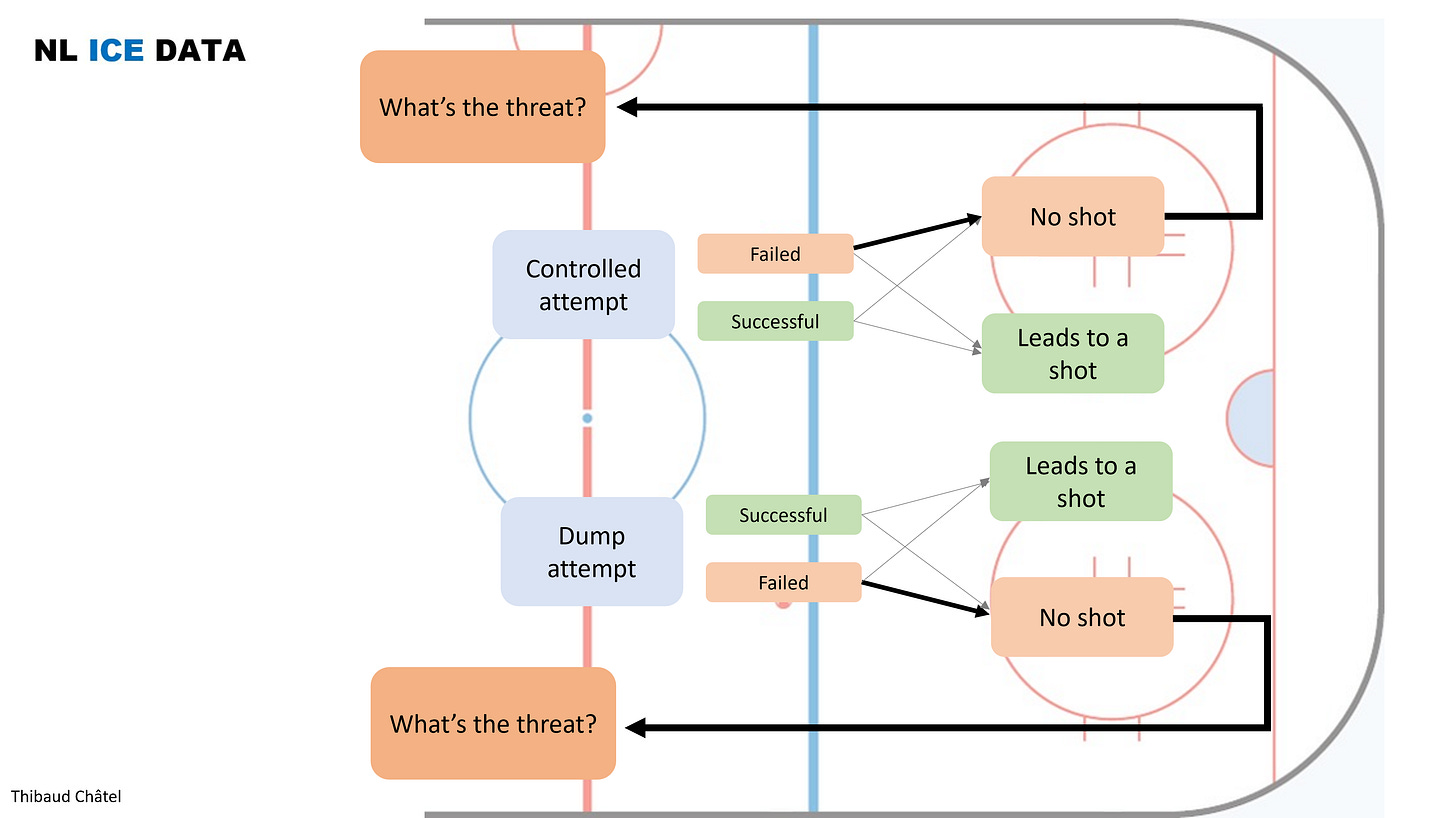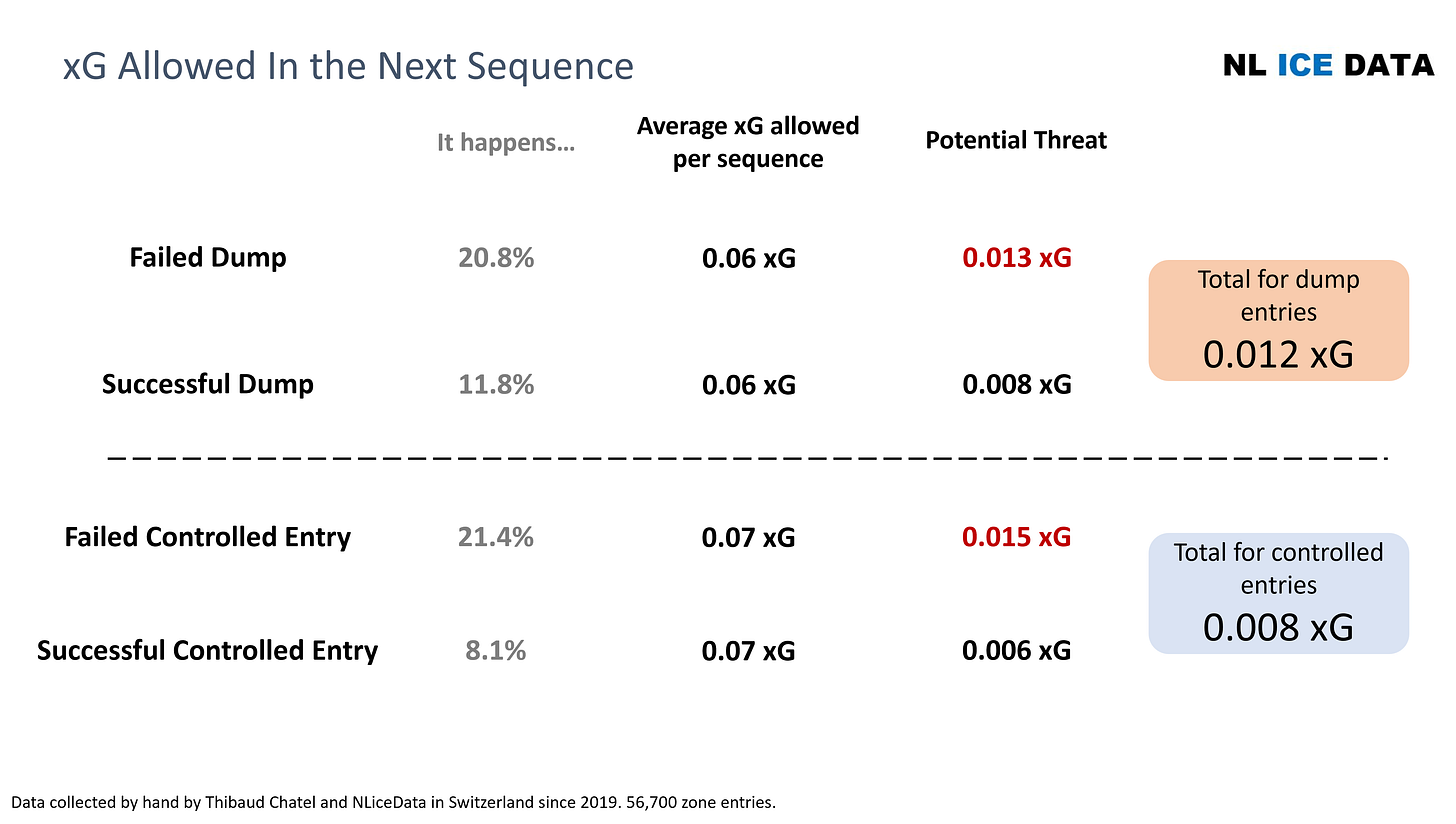Offensive Zone Entries for More Offense And Less Risk
Is it better to Carry or Dump the puck in?
On a zone entry, there are really only two options:
To control the puck via carry/pass
To dump the puck
Dump And Chase Hockey
Dump-and-chase is a hockey tactic where players send the puck deep into the zone they are attacking and then chase after the puck. The chasing/ forechecking team is ceding possession with the hope of gaining it back in a dangerous area via pressuring the opponents.
This offensive tactic was commonplace in the 1990s and 2000s. Starting in the 2010s, the tactic’s usage has dropped significantly and is now considered an “old school” strategy.
Historical Zone Entries
During the summer of 2013 Eric Tulsky, now the Assistant General Manager for the Carolina Hurricanes (and formerly their Director Of Analytics), caused a dramatic shift in how the NHL saw and valued controlled zone entries.
He published his paper, “Using Zone Entry Data To Separate Offensive, Neutral, And Defensive Zone Performance” and presented that at the world’s leading analytics conference, MIT Sloan.
Zach Parise and other star players at the time were quoted on how Tulsky’s research changed how they approached the game that summer:
“I read a study this summer that showed shots generated off carrying the puck in as opposed to dumping it in, and it’s like 4-to-1. It’s not even close,” said Parise “I just found it so interesting because everyone’s like, ‘Forecheck, forecheck, forecheck.’
“I get it, but you dump the puck, you have to get it back. All you’re doing is giving the puck away. I mean, it’s so hard to get it, why would you give it away?”
“I just got kind of, not brainwashed, but my last couple years in New Jersey we were so adamant about dumping the puck in,” Parise said. “But you lose a lot of your creativity and you lose a lot of good touches. I mean, if a ‘D’s in your face, you’ve got no other options and you have to.
“But dump it just to dump it, I’m not a believer anymore in getting rid of the puck when it’s so hard to get. That’s the way we played in New Jersey. We always had a plan: Forwards dumped it in, we knew where it was going and that’s how we got it back. But the more I thought about it, possession is just so much better than dumping it in. Dumping it should be, I don’t want to say your last option, but your second or third option.” - Zach Parise
Research
Regarding zone entries, research has shown that the difference between a controlled entry and a dump-in is about twice as effective in generating offense.
Eric Tulsky (2011/2013) - Tulsky’s Research Paper and his subsequent blog post:
The difference between an odd-man rush and a standard carry-in is significant but not overwhelming (0.78 shots versus 0.57).
Odd-man rushes were found in the NHL to represent less than 3% of all 5-on-5 zone entries.
One dump-and-chase play would add about 0.12 shots on net
One controlled zone entry would add 0.57 shots on net
Therefore, a player needs to be 34% confident of being able to make a successful carry-in to be a favorable decision over a dump-in.
This drops even further when the players on the ice have more skill than their opponents; if they expect to score on 9% of their shots and hold the opponents to 7% then the carry/dump threshold drops to 26%.
Further Research
Thibaud Chatel’s work (2022)
47% of controlled attempts have led to a shot
18% of dump-ins have led to a shot (excluding dump & change)
Corey Sznajder (2014-16)
0.66 shots per carry-in
0.29 shots per dump-in
To say that controlled entries are the preferred way to go about creating offense is nothing new.
What About Risk?
When it comes to entries, people love to point out the cost of turnovers at the blue line.
Historically, dumping the puck in has been considered the safer option.
We were analyzing zone entries with a coach last year and as I was pushing for less dumping, he brought up the “risk argument”. And as we were debating it, he had the only logical request any smart person would have and told me: “prove it to me it is not riskier” - Thibaud Chatel
And no surprises here, failed entries, either controlled or dumped just gave the puck back to the defending team over 90% of the time. Dump-ins still give the puck back more often than controlled entries.
What about quality?
Thibaud found that the average xG allowed by the attacking team in the next sequence after losing the puck, all scenarios (dump or controlled entry, successful or failed) give up on around 0.06 or 0.07 xG to the opponent. Showing that losing the puck after a controlled entry is not riskier after all.
If we take the probability of losing the puck right away, allowing a shot immediately, and the average xG allowed:
A failed controlled entry is still the biggest threat, with a potential 0.015 xG against
A failed dump that has a potential 0.013 xG against you.
Given that a controlled attempt has a threat against of 0.008 xG vs 0.012 xG against for a dump-in. The bottom line is that a dump-in is actually a 33% more dangerous play.
Carries Are Better For Development
There are times to tactically locate/dump the puck in, but it shouldn’t be the default or the primary encouraged tactic.
If you care about player development even a tiny bit, encouraging and allowing players to carry the puck in the zone without fear is the only way to go about creating offensive zone entries. Will there be turnovers? Sure. But in the long-run, it’s better to live and learn that to stymie creativity.
Carrying the puck requires skill and tactical awareness. Players are required to deploy more skills and therefore get more use and practice. From a tactical standpoint, players are required to problem solve and find ways to enter with possession.
Further Reading
Did you enjoy this newsletter?
Help us spread the ideas within and share it with the people you care about




